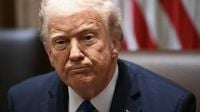Donald Trump took a bold step on March 26, 2025, by signing an executive order aimed at reforming federal elections in the United States. This sweeping order is designed to ensure elections are perceived as 'free, fair and honest,' but many believe it could significantly impact voter participation.
One key provision of the order mandates 'documentary proof' of U.S. citizenship for individuals wishing to register to vote in federal elections. This measure necessitates that voters present specific forms of identification such as a driver’s license, birth certificate, or passport. Additionally, all ballots must be received by Election Day, eliminating the current 'postmarked by' deadlines for mail-in voting. The administration plans to limit the usage of electronic ballots and enable actions to withhold federal assistance from states that do not comply with these new rules.
Trump's executive order raises concerns, particularly as studies suggest that around 9% of U.S. citizens of voting age—equating to approximately 21.3 million people—may not have proof of citizenship readily available. The administration's action may inadvertently disenfranchise a considerable number of potential voters. Voting rights groups have voiced their worries over the possible implications of the new requirements on widespread voter accessibility.
By addressing the current state of electoral processes, the order asserts that the U.S. has failed to enforce necessary election protections. It directs various federal agencies, including the Departments of Homeland Security and Social Security, to collaborate with election officials in states to share voter data to identify and remove non-citizens from voter rolls. The order prioritizes the federal enforcement of election integrity laws in states that do not report suspected election crimes to the national government.
In an announcement made alongside signing the order, Trump remarked, 'this will end it, hopefully,' alluding specifically to his ongoing allegations of election fraud, particularly in regard to the method of mail voting. His history of alleging electoral fraud has been well documented, particularly following his loss in the 2020 presidential election to Democrat Joe Biden, a loss he attributed to widespread fraudulent practices. This order appears to be part of his broader political strategy and aligns with his long-standing skepticism regarding mail-in voting.
Citing the necessity for legislative changes, Trump’s executive order also indicates that he is opting to proceed without waiting for congressional Republicans to pass the proposed Safeguard American Voter Eligibility Act (SAVE Act), which aims to establish similar requirements. Trump supporters argue that such measures are vital to restore public trust in electoral processes, while critics maintain that they are a thinly veiled attempt to undermine voting rights.
Moreover, Trump's action raises significant questions regarding its constitutional legitimacy. The Constitution empowers states to govern their electoral processes, specifying that they have the authority to determine the 'times, places, and manner' of elections. Legal experts, including Justin Levitt, a former policy adviser in the Biden administration, have noted that while the executive branch has some authority over elections, this order is likely to face immediate legal challenges. The broader implications of such an order depend on states' willingness to comply, especially given the ongoing legal and political debates surrounding election conduct.
Currently, 18 states and Puerto Rico still accept mail-in ballots received after Election Day, provided they are postmarked by that date, according to the National Conference of State Legislatures. The new order's requirement for compliance may cause tensions as states grapple with their own laws versus federal directives.
In tandem with the executive order, the Republican National Committee has launched an extensive effort to scrutinize voter registration list maintenance across 48 states and Washington, D.C. The committee has requested public records relating to the maintenance of voter rolls, aiming to ensure transparency about how states are purging ineligible registrations. Trump's actions have energized his base, with proponents emphasizing a need for stricter regulations to combat perceived voting discrepancies. Mike Lindell, an ally of Trump known for propagating election conspiracies, touted the executive order as a necessary reform to rectify what he characterized as 'sick elections.'
Although Trump's executive order has garnered support from certain factions, it has also provoked serious apprehensions among voting rights advocates and has an ambiguous legal standing. For many observers, its eventual implementation remains contingent on the responses from state governments and subsequent judicial interpretations.
As the chapter on this legislative move unfolds, Trump’s administration seems poised to take further actions aimed at enforcing stricter voting laws. The implications of this new executive order will likely ripple across the electoral landscape as states prepare for the coming elections.





